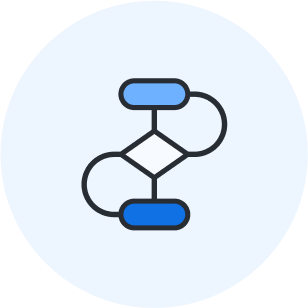
How Lucid’s customer success teams use Lucid to maximize collaboration
Nick Rico
Reading time: about 6 min
As a customer success team, our primary goal here at Lucid is to help our customers get the most out of our products to achieve their goals. To do that, we know we have to be incredibly collaborative—both as an internal team and with our customers.
Fortunately, collaboration is at the core of who we are.
We use Lucid’s products daily to help us capture ideas and feedback, work together to solve problems, and reach alignment.
That collaboration happens at every stage of our post-sale journey—from onboarding big enterprises to providing high-quality support to end users across the globe.
Here’s how we do it.
Create mutual success plans
At Lucid, our customers’ success is our success. That’s why we must understand our customers’ needs and goals. If we deeply understand what they’re trying to accomplish, we can help them use our products to get there.
To drive our mutual success, we use Lucid to create custom mutual success plans.
Here’s how:
-
We start with custom-made templates that are available to the entire team—no need to start from scratch. With shared templates, we can dive right in to collaborate with customers and team members alike to share goals and align on plans.
-
We fill out the plan together with the customer in an engaging, collaborative workshop. Here, the customer provides direct input rather than sitting through a one-sided presentation. This workshop helps us build a stronger relationship with our customers and results in better success plans.
-
Our customer success managers (CSMs) facilitate the planning sessions, and the customer helps us understand who their key players are, the goals they’re after, ideal timelines, and important milestones. All this information gives our CSMs a clear picture of how to engage the customer in the most effective way possible. Win-win!

Customer success toolkit
Get over 15 templates to kick-start workshops, planning sessions, process documentation, and more.
Check it outThese mutual success plans serve as a single source of truth for everyone to reference as we work towards our shared goals. As needs or circumstances change, we can easily update our plans as we go, ensuring the information is always up to date, relevant, and accessible to the entire team.
Build learning maps
We want our users to succeed. The more successful they are, the more we can improve retention and build a clear path toward broader adoption.
Our customer education team creates a variety of resources to show our customers how to get the most value out of our products—from webinars and blog posts to training courses and tutorials. But finding and tracking these resources across different pages can be time-consuming and overwhelming.
So, our team organizes these resources into centralized learning maps within Lucid that are easy to share and follow.
Here’s how we do it:
-
We first bring resources into a Lucidspark board and brainstorm what to include in the learning path.
-
Then, using Lucid’s universal canvas, we switch seamlessly to Lucidchart to start plotting out the basic flow of the learning path in the same space.
-
Once we have the appropriate resources added to the board, we use Visual Activities to vote on the order of the resources on the map and gather additional feedback on how to organize the information.
CSMs follow these paths, continually engaging customers with educational materials that are most relevant to where they are in their progress toward their objectives. These paths allow us to provide better value to our customers and deliver the right resources to the right customers at the right time.
Customer support process flows
With tens of millions of users in over 180 countries, our customer support teams have to manage a complex ecosystem of customer needs, goals, and communication styles. To do this, we need support systems in place that are highly efficient, highly scalable, and prevent knowledge silos across our global team.
That’s why we use Lucid to document all our support process flows.
Here are a few ways we do so:
-
We use Lucidchart to outline detailed processes that our entire support team follows. A few of these processes include account recovery, account owner changes, subscription upgrades, password resets, contact preferences, and invoice requests. We can use existing templates, like this customer support process flow template, and easily customize it to fit our needs.
-
Lucid also helps us continually monitor and improve our processes. We can drop an existing process map into this process improvement template to collaboratively identify potential problems and surface opportunities for improvement.
-
We also use Lucidchart to visually document all the triggers and automated events that take place in our help desk platform. By building a clear picture of ticket flows, we’re able to identify opportunities for automation, helping us scale support in ways that wouldn’t otherwise be possible.
Our support specialists can reference these pages to see exactly what to do when a ticket comes in. With one source of truth, it’s easy to follow the visual flow, helping us resolve issues faster.
Why Lucid customer success teams love using Lucid
Lucid makes it easy for us to eliminate knowledge silos and scale our support processes. Visual documentation is easy to follow, there’s shared understanding among the team, and we’re able to provide our customers with incredibly efficient support that is targeted to their needs and objectives.
We love using Lucid in our daily workflows and customer interactions because it:
-
Clarifies complexity. Teams can visualize complex projects, systems, or ideas with Lucid, helping them reach a shared understanding faster than ever.
-
Offers robust data and automation features. Because Lucid is the most intelligent visual collaboration platform, teams can use advanced automation and data visualization capabilities to save time on manual work and unlock powerful insights that help us drive better experiences for our customers and enable their long-term success.
-
Promotes consistent documentation processes. Lucid is user-friendly (for both technical and non-technical teams), visual, interactive, and effective, which encourages team members to document their processes more consistently. This results in better communication and cross-team alignment, allowing us to deliver exceptional support to our customers.

Discover how Lucid can drive success for your customers.
Request a demoAbout the author

Nick leads all aspects of customer acquisition at Lucid, including demand and lead generation, as well as CRM efforts and performance marketing channels. In his 15-year career, he has brought his experience in customer marketing, financial planning, and pricing analysis to top SaaS technology firms such as Ancestry, Adobe, and Omniture, as well as multinational conglomerates such as G.E. Nick holds a B.S. in corporate finance from the University of Utah and an MBA from Westminster College.
About Lucid
Lucid Software is the leader in visual collaboration and work acceleration, helping teams see and build the future by turning ideas into reality. Its products include the Lucid Visual Collaboration Suite (Lucidchart and Lucidspark) and airfocus. The Lucid Visual Collaboration Suite, combined with powerful accelerators for business agility, cloud, and process transformation, empowers organizations to streamline work, foster alignment, and drive business transformation at scale. airfocus, an AI-powered product management and roadmapping platform, extends these capabilities by helping teams prioritize work, define product strategy, and align execution with business goals. The most used work acceleration platform by the Fortune 500, Lucid's solutions are trusted by more than 100 million users across enterprises worldwide, including Google, GE, and NBC Universal. Lucid partners with leaders such as Google, Atlassian, and Microsoft, and has received numerous awards for its products, growth, and workplace culture.
Related articles
The customer success team’s toolkit for effortless documentation
Here are 20+ Lucid templates to get you started on making your customer success team’s documentation processes effortless.
Guide: How to have effective brainstorms every time
Whether it's in person or virtually, brainstorming effectively with your team isn't easy. Read our guidelines on how to have better brainstorming sessions.
3 ways go-to-market teams use Lucid to facilitate alignment
Go-to-market (GTM) teams are tasked with generating revenue for the business. Here are three ways Lucid helps with that mission.
How to plan a project: A step-by-step guide to project planning
Looking to simplify your project planning workflow? Lucid’s step-by-step guide makes visualizing project planning a breeze.
